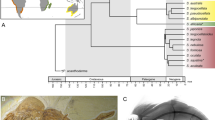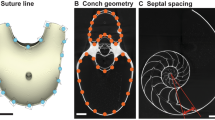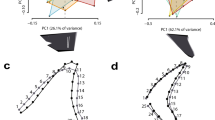Abstract
Acanthodians, an exclusively Palaeozoic group of fish, are central to a renewed debate on the origin of modern gnathostomes: jawed vertebrates comprising Chondrichthyes (sharks, rays and ratfish) and Osteichthyes (bony fishes and tetrapods)1,2,3,4,5,6. Acanthodian internal anatomy is primarily understood from Acanthodes bronni2,7,8,9,10 because it remains the only example preserved in substantial detail, central to which is an ostensibly osteichthyan braincase1,2,7. For this reason, Acanthodes has become an indispensible component in early gnathostome phylogenies1,11,12,13,14,15,16,17. Here we present a new description of the Acanthodes braincase, yielding new details of external and internal morphology, notably the regions surrounding and within the ear capsule and neurocranial roof. These data contribute to a new reconstruction that, unexpectedly, resembles early chondrichthyan crania. Principal coordinates analysis of a character–taxon matrix including these new data confirms this impression: Acanthodes is quantifiably closer to chondrichthyans than to osteichthyans. However, phylogenetic analysis places Acanthodes on the osteichthyan stem, as part of a well-resolved tree that also recovers acanthodians as stem chondrichthyans and stem gnathostomes. As such, perceived chondrichthyan features of the Acanthodes cranium represent shared primitive conditions for crown group gnathostomes. Moreover, this increasingly detailed picture of early gnathostome evolution highlights ongoing and profound anatomical reorganization of vertebrate crania after the origin of jaws but before the divergence of living clades.
This is a preview of subscription content, access via your institution
Access options
Subscribe to this journal
Receive 51 print issues and online access
$199.00 per year
only $3.90 per issue
Buy this article
- Purchase on Springer Link
- Instant access to full article PDF
Prices may be subject to local taxes which are calculated during checkout




Similar content being viewed by others
References
Brazeau, M. The braincase and jaws of a Devonian ‘acanthodian’ and modern gnathostome origins. Nature 457, 305–308 (2009)
Janvier, P. Early Vertebrates (Oxford Univ. Press, 1996)
Hanke, G. F. & Wilson, M. V. H. in Morphology, Phylogeny and Paleobiogeography of Fossil Fishes (eds Elliot, D. K., Maisey, J. G., Yu, X. & Miao, D. ) 159–182 (Freidrich Pfeil, 2010)
Johanson, Z. Vascularization of the osteostracan and antiarch (Placodermi) pectoral fin: similarities, and implications for placoderm relationships. Lethaia 35, 169–186 (2002)
Gai, Z., Donoghue, P. C. J., Zhu, M., Janvier, P. & Stampanoni, M. Fossil jawless fish from China foreshadows early jawed vertebrate anatomy. Nature 476, 324–327 (2011)
Anderson, P. S. L., Friedman, M., Brazeau, M. D. & Rayfield, E. J. Initial radiation of jaws demonstrated stability despite faunal and environmental change. Nature 476, 206–209 (2011)
Miles, R. S. in Interrelationships of Fishes (eds Greenwood, P. H., Miles, R. S. & Patterson, C. ) 63–103 (Academic, 1973)
Nelson, G. J. Gill arches and the phylogeny of fishes, with notes on the classification of vertebrates. Bull. Am. Mus. Nat. Hist. 141, 475–552 (1969)
Jarvik, E. Basic Structure and Evolution of Vertebrates (Academic, 1980)
Miles, R. S. Articulated acanthodian fishes from the Old Red Sandstone of England, with a review of the structure and evolution of the acanthodian shoulder- girdle. Bull. Br. Mus. Nat. Hist. (Geol.) 24, 111–213 (1973)
Zhu, M. et al. The oldest articulated osteichthyan reveals a mosaic of gnathostome characters. Nature 458, 469–474 (2009)
Basden, A. M., Young, G. C., Coates, M. I. & Ritchie, A. The most primitive osteichthyan braincase? Nature 403, 185–188 (2000)
Maisey, J. G. in Major Events in Early Vertebrate Evolution (ed. Ahlberg, P. E. ) 263–288 (Taylor and Francis, 2001)
Miller, R. F., Cloutier, R. & Turner, S. The oldest articulated chondrichthyan from the Early Devonian period. Nature 425, 501–504 (2003)
Zhu, M., Yu, X. & Janvier, P. A primitive fossil fish sheds light on the origin of bony fishes. Nature 397, 607–610 (1999)
Coates, M. I. & Sequeira, S. E. K. in Major Events in Early Vertebrate Evolution (ed. Ahlberg, P. E. ) 241–262 (Taylor and Francis, 2001)
Zhu, M., Yu, X., Wang, W., Zhao, W. & Jia, L. A primitive fish provides key characters bearing on deep osteichthyan phylogeny. Nature 441, 77–80 (2006)
Coates, M. I. & Sequeira, S. E. K. The braincase of a primitive shark. Trans. R. Soc. Edinb. Earth Sci. 89, 63–85 (1998)
Maisey, J. G., Miller, R. & Turner, S. The braincase of the chondrichthyan Doliodus from the Lower Devonian Campbellton Formation of New Brunswick, Canada. Acta Zoologica 90 (suppl. 1). 109–122 (2009)
Maisey, J. G. Braincase of the Upper Devonian shark Cladodoides wildungensis (Chondrichthyes, Elasmobranchii), with observations on the braincase in early chondrichthyans. Bull. Am. Mus. Nat. Hist. 288, 1–103 (2005)
Basden, A. M. & Young, G. C. A primitive actinopterygian neurocranium from the Early Devonian of southeastern Australia. J. Vertebr. Paleontol. 21, 754–766 (2001)
Gradstein, F. M. et al. A Geologic Time Scale 2004 (Cambridge Univ. Press, 2004)
Gardiner, B. G. The relationships of the palaeoniscoid fishes, a review based on new specimens of Mimia and Moythomasia from the Upper Devonian of Western Australia. Bull. Br. Mus. Nat. Hist. (Geol.) 37, 173–428 (1984)
Goodrich, E. S. Studies on the Structure and Development of Vertebrates (Univ. Chicago Press, 1930)
Goujet, D. Les Poissons Placodermes du Spitsberg (Cahiers de Paléontologie, Section Vertebres, Centre national de la Recherche scientifique, 1984)
Maisey, J. G. & Lane, J. A. Labyrinth morphology and the evolution of low-frequency phonoreception in elasmobranchs. C. R. Palevol 9, 289–309 (2010)
Pradel, A. et al. Skull and brain of a 300 million year old chimaeroid fish revealed by synchrotron holotomography. Proc. Natl Acad. Sci. USA 106, 5224–5228 (2009)
Maisey, J. G. The postorbital palatoquadrate articulation in elasmobranchs. J. Morphol. 269, 1022–1040 (2008)
Wills, M. A. Crustacean disparity through the Phanerozoic: comparing morphological and stratigraphic data. Biol. J. Linn. Soc. 65, 455–500 (1998)
Ruta, M. Phylogenetic signal and character compatibility in the appendicular skeleton of early tetrapods. Spec. Pap. Palaeontol. 86, 1–21 (2011)
Swofford, D. L. PAUP*: Phylogenetic Analysis Using Parsimony (and Other Methods) v.4.0b10 for PC (Sinauer Associates, 2002)
Felsenstein, J. Confidence-limits on phylogenies—an approach using the bootstrap. Evolution 39, 783–791 (1985)
Bremer, K. The limits of amino-acid sequence data in angiosperm phylogenetic reconstruction. Evolution 42, 795–803 (1988)
Eriksson, T. AutoDecay v. 5.0. (2001)
Davis, J. C. Statistics and Data Analysis in Geology (John Wiley and Sons, 1986)
Creanza, N., Schwarz, J. S. & Cohen, J. E. Intraseasonal dynamics and dominant sequences in H3N2 influenza. PLoS ONE 5, e8544 (2010)
Sokal, R. R. & Rohlf, F. J. Biometry (W. H. Freeman, 1995)
Acknowledgements
We thank R. Paton, Z. Johanson, M. Richter, J. Clack, D. Unwin and W. Simpson for specimen loans and collections access; M. Friedman, M. Brazeau, G. Hanke and J. Long for discussions on early gnathostome cranial anatomy. Financial support for this work was provided by Natural Environment Research Council (UK) studentship GT4/97/183ES, and grant DEB-0917922 from the National Science Foundation (USA) (to M.I.C.).
Author information
Authors and Affiliations
Contributions
S.P.D. completed the original data collection and initial analysis. S.P.D. and M.I.C. contributed to anatomical analysis, initiated the project and assembled the comparative data set. J.A.F. performed quantitative phenetic analyses. M.I.C. and J.A.F. contributed to phylogenetic analysis and figure preparation. All authors contributed to manuscript preparation.
Corresponding author
Ethics declarations
Competing interests
The authors declare no competing financial interests.
Supplementary information
Supplementary Information
This file contains Supplementary Figures 1-20, Supplementary Tables 1-8, Supplementary Notes 1-2 and Supplementary References – see Contents list for details. (PDF 12283 kb)
Rights and permissions
About this article
Cite this article
Davis, S., Finarelli, J. & Coates, M. Acanthodes and shark-like conditions in the last common ancestor of modern gnathostomes. Nature 486, 247–250 (2012). https://doi.org/10.1038/nature11080
Received:
Accepted:
Published:
Issue Date:
DOI: https://doi.org/10.1038/nature11080
This article is cited by
-
Hagfish genome elucidates vertebrate whole-genome duplication events and their evolutionary consequences
Nature Ecology & Evolution (2024)
-
Broad snouted cladoselachian with sensory specialization at the base of modern chondrichthyans
Swiss Journal of Palaeontology (2023)
-
The erroneous chondrichthyan egg case assignments from the Devonian: implications for the knowledge on the evolution of the reproductive strategy within chondrichthyans
The Science of Nature (2021)
-
Endochondral bone in an Early Devonian ‘placoderm’ from Mongolia
Nature Ecology & Evolution (2020)
-
A symmoriiform from the Late Devonian of Morocco demonstrates a derived jaw function in ancient chondrichthyans
Communications Biology (2020)
Comments
By submitting a comment you agree to abide by our Terms and Community Guidelines. If you find something abusive or that does not comply with our terms or guidelines please flag it as inappropriate.



